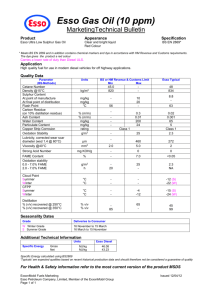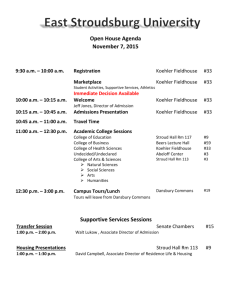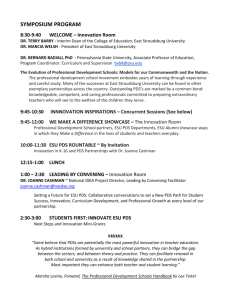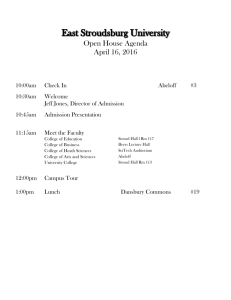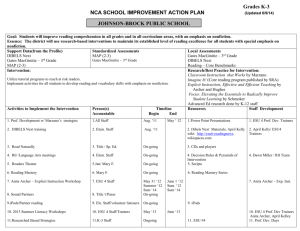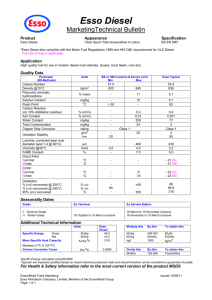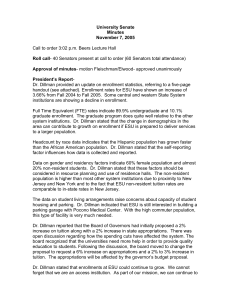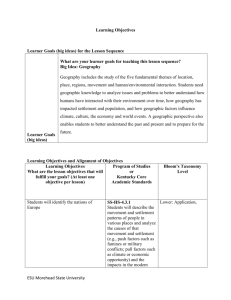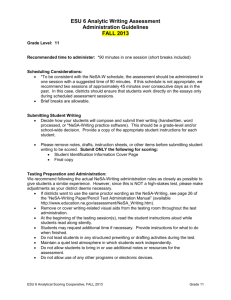November 2005
advertisement
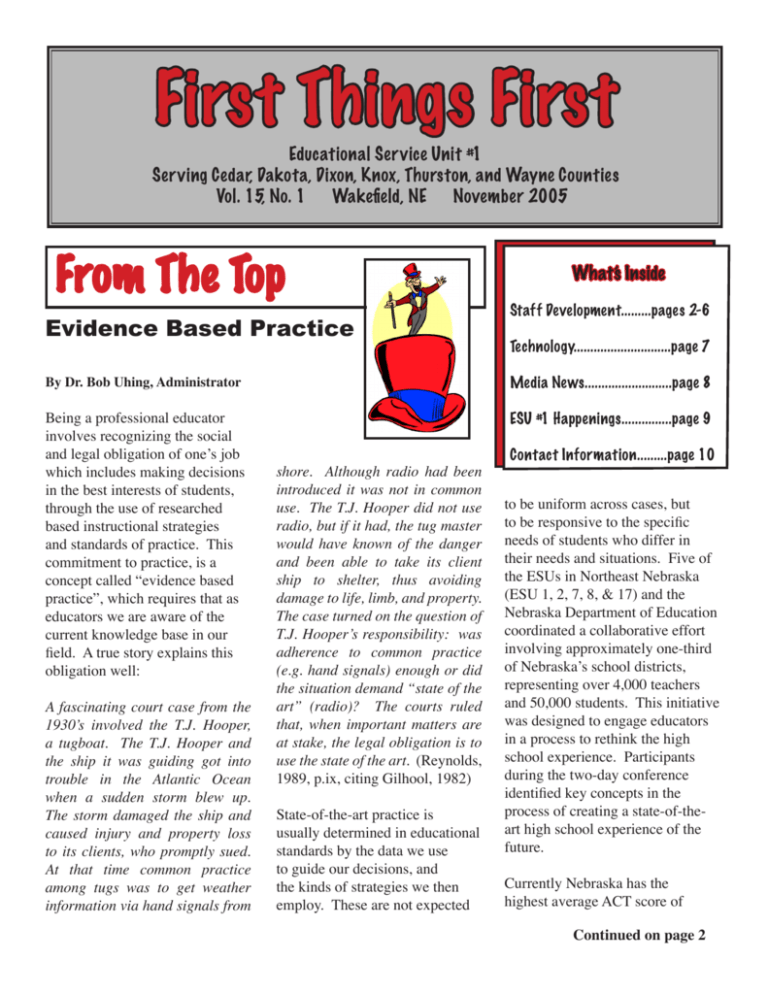
First Things First Educational Service Unit #1 Ser ving Cedar, Dakota, Dixon, Knox, Thurston, and Wayne Counties Vol. 15, No. 1 Wakefield, NE November 2005 From The Top Evidence Based Practice What’s Inside Staff Development.........pages 2-6 Technology.............................page 7 By Dr. Bob Uhing, Administrator Media News..........................page 8 Being a professional educator involves recognizing the social and legal obligation of oneʼs job which includes making decisions in the best interests of students, through the use of researched based instructional strategies and standards of practice. This commitment to practice, is a concept called “evidence based practice”, which requires that as educators we are aware of the current knowledge base in our field. A true story explains this obligation well: ESU #1 Happenings...............page 9 A fascinating court case from the 1930ʼs involved the T.J. Hooper, a tugboat. The T.J. Hooper and the ship it was guiding got into trouble in the Atlantic Ocean when a sudden storm blew up. The storm damaged the ship and caused injury and property loss to its clients, who promptly sued. At that time common practice among tugs was to get weather information via hand signals from shore. Although radio had been introduced it was not in common use. The T.J. Hooper did not use radio, but if it had, the tug master would have known of the danger and been able to take its client ship to shelter, thus avoiding damage to life, limb, and property. The case turned on the question of T.J. Hooperʼs responsibility: was adherence to common practice (e.g. hand signals) enough or did the situation demand “state of the art” (radio)? The courts ruled that, when important matters are at stake, the legal obligation is to use the state of the art. (Reynolds, 1989, p.ix, citing Gilhool, 1982) State-of-the-art practice is usually determined in educational standards by the data we use to guide our decisions, and the kinds of strategies we then employ. These are not expected Contact Information.........page 10 to be uniform across cases, but to be responsive to the specific needs of students who differ in their needs and situations. Five of the ESUs in Northeast Nebraska (ESU 1, 2, 7, 8, & 17) and the Nebraska Department of Education coordinated a collaborative effort involving approximately one-third of Nebraskaʼs school districts, representing over 4,000 teachers and 50,000 students. This initiative was designed to engage educators in a process to rethink the high school experience. Participants during the two-day conference identified key concepts in the process of creating a state-of-theart high school experience of the future. Currently Nebraska has the highest average ACT score of Continued on page 2 Staff Development Evidence Based Practice, cont. the 13 states where at least 70 percent of graduating seniors took the test. However, higher education and business leaders are concerned about skill levels of high school graduates and their ability to succeed in college or work. Based on my experience at this conference and working with schools in our area, being on the “cutting edge” of the High School reform movement is important. Hand signals are not an option. A great deal of work is going on addressing student achievement K-12. School staff should be very proud of your accomplishments. Schools in Nebraska, especially in ESU #1, make great efforts to ensure a quality education for all students. The ultimate goal is to have all students prepared for college and the workplace when they graduate. We need to continue to strive towards the “evidence based practice” that will help us reach our goal . Learning Communities Embrace Career Clusters/Fields By Rhonda Jindra, ESU #1 Staff Development Educational Service Units #1, 10 & 17 received a Carl Perkins Innovation grant for the 2005-06 school year. The purpose of the grant is to create district learning communities which explore professional literature, making connections between what they are reading and the implementation of Career Fields/Clusters throughout the district. Two ESU #1 learning communities have been created: Laurel-Concord and Wausa. Participating for Laurel-Concord are Les Owen, Stephanie Peterson, Shelley Groene, Marta Victor, Pam Thies, and Sue Brandow. Joining Wausaʼs team are Dawn Friedrich, Greg Conn, Ann Pfeil, Marge Nelson If you would like to view the web site the conference participants created, it can be found at: http://www.innovationlabs.com/ newhighschool/blog.html Checking out the details Greg mentioned is Ann Pfeil, Wausa English educator. November 2005 Greg Conn, Wausa Guidance Counselor, offers the first report. and Connie Vanness. In addition, Wausa has included Mary Snowdon, Niobrara Guidance Counselor, on their team. All learning communities from ESU #1, 10 & 17 attended a twoday session in early August to learn about the process and begin their responsibilities. During this time, each learning community set a preliminary schedule for their fall meetings. Each meeting is conducted during non-contract time and members discuss the specific book they have read for that particular session. Books include Educators as Learners, Qualities of Effective Teachers, Building Shared Responsibility for Student Learning, A Mind at a Time, and Transforming Schools: Continued on page 3 Page 2 Staff Development Learning Communities, cont. Creating a Culture of Continuous Learning. Each book was carefully chosen to inspire high quality instruction for student achievement. In addition, professional reading will spark connectedness among the members, assisting them as they seek to implement the Career Fields/Clusters K-12. Mary Snowdon of Niobrara is engaged! Energized! Ready for the next step! Career Fields/Clusters prepares students for career choices from kindergarten to career. In elementary, this includes career awareness and as a middle school student, career exploration such as job shadowing and the implementation of personal learning plans (PLPs). Secondary and post-secondary education includes career preparation and application such as mentorships, part-time work, service learning, and internships. In addition, PLPs continue. By participating in this November 2005 project, Laurel-Concord and Wausa are creating a process back at the district for the successful implementation of Career Fields/ Clusters. They are also creating a “model” for the State of Nebraska that can be used to assist other districts as they implement the process within their educational setting. Recently, I had the opportunity to attend one of the Wausa/Niobrara learning community meetings. They met on October 19 at Niobrara Public School. The meeting was engaging, thoughtprovoking, and built upon support and encouragement for one another. In the near future, I will be joining the Laurel-Concord learning community for one of their meetings. In January, the learning communities across ESU #1, 10 & 17 will reconvene at the Grand Island Interstate Holiday Inn to explore PLPs and share their progress implementing Career Fields/Clusters at their district. In addition, each learning community meets one day each semester at their respective ESU to explore Career Fields/Clusters further. ESU #1 districts will meet at Wakefield on November 2 and begin their session by working with the Nebraska Career Information System (NCIS) software and then meeting Learning together. Teaching one another. Thatʼs the power of learning communities. with the ESU #17 district via distance learning during the afternoon. Learning communities are a powerful professional development experience. Not only do the Laurel-Concord and Wausa/Niobrara communities building instructional capacity, they are also creating relationships that will invite continued personal and professional growth and reflection. If you would like to implement learning communities at your district, please contact me for further information (402-287-2061). You can also contact the Laurel-Concord and Wausa/Niobrara learning communities for first-hand experience. Page 3 Staff Development 2 Trainings Keep 20 Math Teachers Busy By Amy Hill, ESU #1 Staff Development ESU #1 has been in a collaborative partnership with Wayne State College, Northeast Community College and the secondary school districts we work with to provide professional development in 7-12th grade mathematics. This effort has focused on content knowledge and teaching skills pertaining to Algebraic Concepts and Data Analysis, Probability and Statistics. Twenty mathematics educators from public and private schools have attended summer institutes and school year follow-up training that is aligned to the Nebraska and NCTM Mathematics Standards and utilizes research based best teaching practices. This past summer, nineteen 7-12th grade mathematics educators participated in training, led by Dr. Jeff Bauer, Wayne State College. Instruction focused on Fostering Algebraic Thinking based on Mark Driscollʼs work. A second summer training involved integrating data analysis and probability with concepts from algebra and pre-calculus using technology. The emphasis was on hands-on teaching and learning, in addition to integrating activities with TI-83 graphing calculators. Twenty educators participated in this training led by instructors Dr. Tami Worner, Wayne State College; Beth Welke, Northeast Community College; and Dan Hackbarth, Greendale High School, Greendale, Wisconsin. On-line learning is currently being utilized to increase the level of educator implementation of instructional strategies in the classroom as part of the school year follow-up. Teachers are posting lesson plans, instructional ideas, and participating in discussion threads each month. This follow up is being facilitated by Dr. Robert Sweetland, Wayne State College. Funding for this project is made possible through the Nebraska Mathematics and Science Partnership grant program which is federally funded under Title II, Part B of the Elementary and Secondary Education Act, as amended by the No Child Left Behind Act of 2001. Terry Hagen and Rod LʼHeurex work with instructor Beth Welke. November 2005 ESU #1 7-12 math educators listen to Professor Jeff Bauer. Instructor Dan Hackbarth works with Mary Beth and Ray Weier Page 4 Staff Development The Nebraska 100 By Rhonda Jindra, ESU #1 Staff Development Transformation and renewal begins with a conversation. And not just any conversation, but one that is built upon ideas gleaned from books, articles, interviews and personal experience. At the recent Rethinking the High School Conference, these conversations formed the foundation for a thought-filled two days at Northeast Community College. One hundred administrators, educators, and education partners, including Educational Service Units #1, 2, 7, 8 & 17 and the Nebraska Department of Education, participated at the conference. Affectionately coined “The Nebraska 100”, this group of educational partners brainstormed what the high school experience might look like if ALL students were successful. Participants joined a variety of small group discussions, exploring a variety of issues including personalized education, authentic assessment and integration within the high school setting. In the midst of the first dayʼs activities, small groups also examined “change” and how to embrace it within the realm of “Weʼve always done it that way”. This sparked discussion related to challenges back at the district when educators are asked to change in an environment they already view as “good”. During the second day of the conference, nine key concepts emerged. These concepts included the following: • A sense of purpose • Personalized learning • A vision for what “it” looks like when itʼs done • Innovative assessment • Relationships with students • Broader responsibility • Connected learning (inte grated, interdisciplinary, relevant learning) • Teacher as facilitator • Learning Communities. Participants chose to work in the area with which they were most passionate. Ideas were created from the lively conversations and then shared in rotating sessions. Summaries were created, added to chart paper and then posted for Continued on page 6 Justin Wagner of South Sioux City writes ideas as his team brainstorms. Emerson-Hubbard in action! November 2005 Page 5 Staff Development Nebraska 100, cont. further examination. During the afternoon, district teams worked together, creating a plan of action for the concepts that would be implemented back at the district. Each district then reported their plan to the large group. A final activity included meeting with each districtʼs respective ESU, sharing their needs to make the plan a reality back at the district. Innovation Labs, who facilitated the conference process, created a website throughout the entire event. Conversations were captured, pictures were uploaded and pictoral summaries were created to highlight additional large group discussions. The website is avail- able for viewing at http://www. innovationlabs.com/newhighschool/blog.html ESU #1 participating districts (Emerson-Hubbard, Pender, Wakefield, Wayne and South Sioux City) have agreed to continue this process back at the district for at least two to three years. In addition, they will meet periodically at ESU #1 for continued networking and professional development. Based on the needs each district shared at the conclusion of the Rethinking the High School Conference, additional support will be provided related to personal learning plans, the teacher as facilitator, and the suc- cessful implementation of advisory groups. The next sharing session will be held on December 7th at ESU #1. The Nebraska 100 carries the vision to each student, educator, administrator, parent and patron back at the district. One person at a time, they can create a meaningful high school experience which prepares their students for an opportunity-filled future. For further information, please contact Bob Uhing, Rhonda Jindra or Shannon Collin at ESU #1. They can be reached at (402) 287-2061. Below: Bill Heimann, Casey Hurner, Bill Trenhaile, and Mike Moody of Wakefield report on their implementation plan. Above: The Nebraska 100” brainstorming the challenges high schools face today and how to meet them. November 2005 Above: Carol Hilker, Greg Conroy, and Deb Walsh of Pender work to determine the next steps their school will take. Page 6 Technology Internet Safety By Lanita Recob, ESU 1 Technology Trainer While surfing the web or using the computer to communicate: 1 in 5 children under 17 years of age have received unwanted sexual solicitation. 1 in 33 children have received an aggressive solicitation to meet somewhere. 1 in 4 children ages 10-17 have been exposed to pornography. Below are several websites with internet safety information, curriculum, games, and parent resources. Teacher Resources Parent Resources www.techcorps.org/resources/internetsafety/index.html www.websafecrackerz.com Online safety games www.bonus.com www.wiredkids.org www.websafecrackerz.com Teaching kids to be safe online www.media-awareness.ca Julie Posey’s site pedowatch.com United Streaming Irate about ERATE! Safe Surfing with your family yahooligans.yahoo.com/parents/ Protect Kids – Parental Control www.protectkids.org/solutions.htm Family Education www.familyeducation.com Safe Kids www.safekids.com ESU #1 is providing streaming of videos and video clips at www.unitedstreaming.com Contact the Media Specialist in your school for information. By Jim Hopkins, ESU 1 Technology Coordinator Well, itʼs time to get ready for the new cycle of erate work. Although it is terribly time consuming and the forms never seem to end, we save our schools thousands and thousands of dollars. So please try to keep up with the timelines. First, donʼt forget the Tech Plans. They have to be updated EVERY year. It will need to be updated prior to submitting Form 470 requesting service. You can get to the tech plan submission page by going to our home page (http://www.esu1.org) under the Tech Planning area. After Tech Plans are done, submit your Form 470. Please be aware that we will be requesting several items from your schools to keep on file in case ESU #1 gets audited. Thank you in advance for your cooperation. November 2005 Page 7 News a i d e M Jenny Heimann Driverʼs Education DVD ESU #1 DVD Promotion Each Media Specialist received a list of titles purchased by ESU #1 for the 2005-2006 school year. Five DVD orders received from each Media Specialist by November 30 will be copied and sent FREE of charge. School districts will be charged the regular rate of $2.00 per title for all DVD orders received after November 30 or after receiving five FREE DVDʼs. DVDʼs are stored at the ESU. Please contact the Media Specialist in your school for more details. DVD-050A* Rules of the Road 105 Minutes Topics Include: Driving Basics, City and Residential Driving, Highway Driving, The Driverʼs Exam, Safety Tips, Tips for Hazardous Conditions, Drug and Alcohol Awareness, Interactive Features and Bonus Features This DVD cannot be copied. Contact your Media Specialist to order. To view the Media Catalog: go to www.esu1.org, departments, media, search the media catalog FREE Video The National Arbor Day Foundation is currently offering a free copy of the video Arbor Day: The Holiday That Makes a Difference to schools. The nineteen minute video is designed for upper elementary aged children and offers inspiring examples of young people who are keeping the Arbor Day tradition alive by planting and caring for trees in their communities. Straight from the home of Arbor Day, forestry experts and kids talk about the benefits of tree planting and the impact trees have on the environment and our lives. Discover the Arbor Day story of a young man named J. Sterling Morton and his vision of transforming the barren Midwestern prairie into a land blessed with trees: trees for shade, food, fuel, building materials and beauty. Through Mortonʼs leadership the Arbor Day holiday was born. To receive your free copy, send your name, school, shipping address to: National Arbor Day Foundation, Arbor Day Video, P.O. Box 85784, United Streaming November 2005 ESU #1 is providing streaming of videos and video clips at www.unitedstreaming.com Contact the Media Specialist in your school for information. Page 8 ESU #1 Happenings ESU #1 is always a busy place. Take a look at a few of the snapshots from some of the many trainings that have happened this year. Above: Garage Band participants work with their computers. Above: ESU #1 Media Specialists listen to speaker Dorothy Willis from UNO. Left: Teachers work to align their districtʼs social studies curriculum to state standards. Above: Jeff Ingraham facilitiates a Garage Band training. UPCOMING WORKSHOPS Dealing With Bullying a conference sponsored by KAPPA DELTA PI Date: Time: Where: Topics: November 17, 2005 6:00 PM to 9:00 PM Wayne State College Student Center The BULLY - Some Defining Characteristics Strategies for dealing with the BULLY Relating the Community to the School November 2005 Workshops are continuously being added to the calendar. Because cancellations and reschedulings occur from time to time, a complete listing has not been included. However, you can keep up to date on the latest workshop information by going to http://www.esu1.org. Click on ESU Newsletter. From there, you can print a monthly calendar. Make sure to check back frequently for updates. Page 9 Contact Information The Educational Service Unit #1 staff welcomes your questions, ideas, and concerns. We look forward to hearing from you. Below is a listing of our central staff and their emaill addressess. Administration Dr. Bob Uhing, Administrator Kim Neal, Special Education Director Lisa Salmon, Business Manager buhing@esu1.org kimneal@esu1.org lsalmon@esu1.org Central Office Support Staff Wendy Ellis, Secretary/Media Assistant Sarah Elton, Secretary/Receptionist Joleen Gustafson, Special Education Secretary Diane Keim, Accounting wellis@esu1.org selton@esu1.org jgustaf@esu1.org dkeim@esu1.org Professional Development Amy Hill, Staff Development Coordinator Rhonda Jindra, Staff Development Coordinator Shannon Collin, Staff Development Coordinator Susan Strahm, Early Childhood Staff Development Coordinator ahill@esu1.org rjindra@esu1.org scollin@esu1.org sstrahm@esu1.org Technology/Media Jim Hopkins, Technology Coordinator Jenny Heimann, Media Lanita Recob, Technology/Media jhopkins@esu1.org jheimann@esu1.org lrecob@esu1.org Program Coordinators Cheri Matthews, Early Childhood Special Education Ron Lorenzen, School Psychologist Leah Moritz, ILCD Peg Roush, Speech Language Larry Athey, Transition November 2005 cmatthew@esu1.org rlorenze@esu1.org lmoritz@esu1.org proush@esu1.org lathey@esu1.org Page 10
